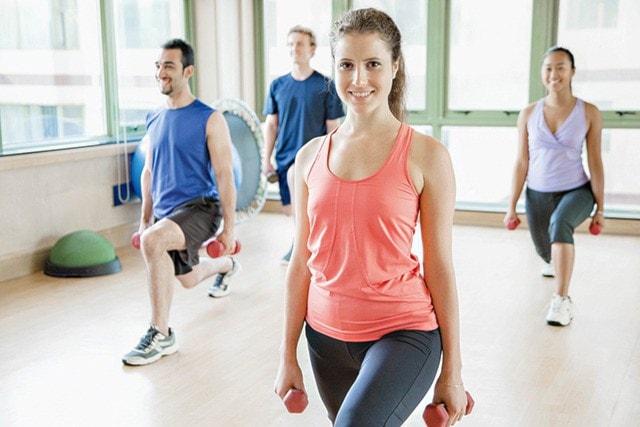The lunge is one of the most common lower body strength exercises, and one that definitely deserves some attention.
The lunge is one of the basic movement patterns, and lunging one of the most effective ways to strengthen and sculpt your lower body. Better than the leg press, leg extension and leg curl machines, the lunge targets your quadriceps, hamstrings, buttocks and calves. The lunge requires little or no equipment and also improves your balance and mobility. Adding lunges to your program is great for both function and looks.
One word of caution: if have a history of knee pain, or experience knee pain during the exercise, stop! Lunges may aggravate your condition, especially if they are done incorrectly.
Here’s how you do a basic forward lunge:
Start by standing tall. Take a big step forward, keeping both feet pointing forward.
Initiate the movement by bending the back knee (versus shifting your weight forward into the lunge). Your back heel will lift off the floor. Keep your upper body upright (don’t lean forward). Your front knee should stay overtop of your ankle. Be sure that your front knee does not turn inward or outward; your front knee should stay in line with the second and third toes. Mirrors can help you perfect your form.
Once you have lowered down toward the floor, engage your core and push back off your front foot and return to starting position. You have now completed a basic forward lunge!
One of the best parts about the lunge is that there are countless variations of the basic movement. Here are a few:
Stationary lunge: Start like the forward lunge. Instead of pushing off the front leg back to starting position, keep both feet planted and pulse up and down for each repetition. The stationary lunge is a great beginner’s lunge. If balance is a challenge, do the stationary lunges in a doorway so you can hold on if you feel unsteady.
Add a weight: Like any other exercise, adding a weight to the lunge increase the challenge. You can hold onto a dumbbell in each hand, or hold onto a barbell across your chest.
Move with the lunge: Start with the forward lunge. Instead of pushing off the front leg, push off the back foot and take a large step forward into the next lunge. The walking lunge is a great way to target the buttocks. If you are new to the walking lunge, step your feet together before stepping forward into the next lunge.
Add upper body exercises: Work the upper body while building strong legs. Add a bicep, shoulder or triceps exercise to the lunge. For example, a walking lunge can be paired with a biceps curl. Holding two dumbbells, pause during the lunge to perform a bicep curl.
Challenge your balance: While doing walking lunges, push off your back leg and hold a one-legged stance for a few counts before continuing to the next lunge. The balance hold is a great time to perform an upper body exercise such as an overhead shoulder press.
Step it up: Place your back foot on a step, stability ball, or bench to put more emphasis on the front leg.
Change directions: Instead of lunging forward, lunge to the side. Take a big step out to the right, keeping both feet pointing forward. Shift your weight right and bend at your right knee, keeping your left leg straight. Ensure that your right knee stays in line with your right toes.
To keep your legs strong, make sure to add lunges to your exercise program. Try different variations of the lunge to challenges your muscles in new ways and to keep your program new and interesting.
Tanja Shaw is a health and fitness coach, Rotarian, passionate entrepreneur, mom, runner, and owner of Ascend Fitness Inc. and host of the Fit & Vibrant You Podcast. Tanja and her team of expert fitness coaches inspire and coach others to become stronger, more confident and energetic versions of themselves. Visit Tanja at www.ascendfitnesscoaching.com and www.tanjashaw.com.
